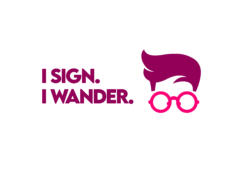There are problems specific to Deaf people, but what are they?
1. Running out of toilet paper in a deaf house.

2. When you’re expecting a parcel delivery, you cancel your errands and appointments for the entire day to wait at the front door because you cannot hear the doorbell. You don’t dare to go for pee/food breaks, to blink or move away from the front door.

3. Being stranded at the train station because the screen tells you to listen for announcements, only to miss your train due to a cancellation or platform change because you are unable to hear the announcements.

4. When you notify someone that you are deaf, they start pulling the ‘HAMBURGER’ talk – speaking extremely slow as if they are spelling each letter.

5. Forgetting your hearing aid/cochlear implant batteries when you go out.

6. When someone thinks you cannot drive because you’re deaf.

7. When someone says that you don’t look deaf.

8. When people expect you to lip read…

9. Watching a crap interpreter is like watching Netflix with a shitty Internet connection.

10. When you’re at the movies and the Captiview doesn’t work.

11. When you cook an epic meal and you don’t hear the smoke alarm going off.

12. When the shop attendant keeps missing the item you’re pointing to on the menu.

13. When the lecturer turns off the lights and you cannot see the interpreter at all.

14. When your phone keeps ringing with the same number for days but you cannot call back through the relay service to tell them to stop because it’s a private number.

15. When you text someone saying that you’re deaf, but autocorrect changes it to dead.

16. When someone looks at you in amazement and say “You speak so WELL! You’d never know…” with their eyebrows lowered like you have a dirty little secret.

17. When you’re in the middle of a video or NRS call, and the electricity is turned off…which means the Internet is cut off.

18. When you come home after a night out, only to realise you forgot your keys and everyone in your house is deaf.

19. Watching a TV program with crappy captions.

20. When you have a shower, and realise you forgot your towel. You cannot yell out “SOMEONE GET ME A TOWEL PLEASE” because the entire house is deaf, so you have no choice but run to your room au naturale, hoping no one sees you.

A massive THANK YOU to those who contributed!
Yours in #deafproblems
S xo


17. Happened to me few times when NRS suddenly disconnected in the middle of an important call. Arrggghh
Sometimes it’s nice to be deaf as not need hear noises of all kinds like vacuum cleaner , car honking, dog barking , baby crying , fire truck siren, police car siren, alarm clock,
Newspaper rattling or rustling, strange
Noises like water dripping, toilet water running as out of order, car parts noises, endless noises but we appreciate to have new technology to have door bell alarm light flashing, same with fire alarm fishing strobe, smoke alarm too, wear alert necklace to contact to security officer for emergency, buy plenty of toilet rolls, towels, light bulbs, use I-Phone and I-Pad to contact friend or relative for help to get 911. We try our best to get comfortable while we can’t hear. We have eyes to watch out for fire truck or ambulance. Anything we can do but hear.
#13 has been my worse.
Pingback: 20 #DeafProblems | I Sign. I Wander. | Can't Remember Diddly!
16 & 19. And I’d like to add, fuck you, YouTube, for thinking autocaptions are even close. It’s infuriating. I’d really love to learn that thing I just looked up; you’re teaching away, I’m headdesking.
Not listed: Webinars or online courses that aren’t captioned. Asking the instructor before you buy it, and they’re all, no, but I have PowerPoint slides so you can follow along fine. Yes, so many nuances are imparted through bullet points. Thanks for nothing, buddy.
It’s about time Netflix and other streaming site should realise including deaf customers would make them a bigger viewers base i wont pay for something i cant have full aCCESS TO